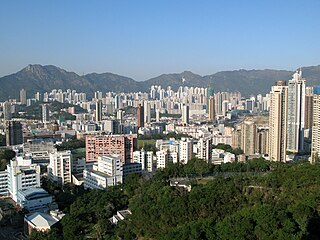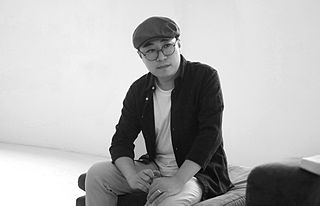Related Research Articles

Kowloon City is an area in New Kowloon, Hong Kong. It is part of Kowloon City District.

Kowloon Walled City was a densely populated and largely ungoverned enclave of China within the boundaries of Kowloon City, British Hong Kong. Built as an Imperial Chinese military fort, the walled city became a de jure enclave after the New Territories were leased to the United Kingdom in 1898. Its population increased dramatically after the end of the Japanese occupation of Hong Kong during World War II, attracting mostly refugees fleeing the renewed Chinese Civil War. By 1990, the walled city contained 50,000 residents within its territory of 2.6 hectares. From the 1950s to the 1970s, it was controlled by local triads and had high rates of prostitution, gambling, and drug abuse.

Kowloon Tong (Chinese: 九龍塘) is an area of Hong Kong located in Kowloon. The majority of the area is in the Kowloon City District. Its exact location is south of the Lion Rock, north of Boundary Street, east of the East Rail line and west of Grampian Road. It is one of the most expensive residential districts in Hong Kong.

The Peninsula Hong Kong is a colonial-style luxury hotel located in Tsim Sha Tsui, Kowloon, Hong Kong. It is the flagship property of The Peninsula Hotels group, part of the Hong Kong and Shanghai Hotels Group. The hotel opened in 1928 and was the first under The Peninsula brand. Expanded in 1994, the hotel combines colonial and modern elements, and is notable for its large fleet of Rolls-Royces painted a distinctive "Peninsula green".
Several buildings carry the HSBC name, and some are often referred to as HSBC Building, HSBC Tower or both:
Lawrence Kadoorie, Baron Kadoorie, CBE was a Hong Kong industrialist, hotelier, photographer and philanthropist.

Kowloon City District is one of the 18 districts of Hong Kong. It is located in the city of Kowloon. It had a population of 381,352 in 2001, and increased to 418,732 in 2016. The district has the third most educated residents while its residents enjoy the highest income in Kowloon. It borders all the other districts in Kowloon, with Kwun Tong district to the east, Wong Tai Sin district to its northeast, Sham Shui Po district to its northwest, and Yau Tsim Mong district to its southwest.
Qiu Zhijie is a contemporary Chinese artist who works primarily in video and photography. Overall, Qiu's work suggests the struggle between the forces of destiny and self-assertion. Other common themes are social fragmentation and transience.

Kenneth Robert Lum, OC DFA is a dual citizen Canadian and American academic, painter, photographer, sculptor, and writer. Working in a number of media including painting, sculpture and photography, his art ranges from conceptual in orientation to representational in character and is generally concerned with issues of identity in relation to the categories of language, portraiture and spatial politics.
Michael Wolf was a German born artist and photographer who captured daily life in big cities. His work takes place primarily in Hong Kong and Paris and focuses on architectural patterns and structures, as well as the documentation of human life and interaction in the city. Wolf has published multiple photo books, has had his work exhibited widely around the world, has permanent collections across Germany and the United States, and has won three World Press Photo Awards from 2005 to 2011.

Ryūji Miyamoto is a Japanese photographer, best known as the “ruins photographer”. Having studied graphic design at Tama Art University in Tokyo, he taught himself photography and began as an architectural journalist for magazines and newspapers. Inspired by the landscapes of post-war Japan that marked his childhood he came to reckon the imagery of destruction when he received a commission from Asahi Graph to document the demolition of the Nakano Prison in Tokyo.

Nikko Hotels International is an international hotel chain comprising Hotel Nikko properties in Asia, Europe, North America, and the South Pacific. It is owned by Okura Hotels. Nikko Hotels International (NHI) began operations in 1972 as the global hotel brand of Japan Airlines, with its first property located in Jakarta. The first NHI-operated hotel in Japan opened in 1973. Other Nikko properties have been owned and operated by other entities; among the oldest Nikko properties is the Ginza Nikko, which opened in 1959.

The North Kowloon Magistracy is a historic building and former Magistrate's Court located at No. 292, Tai Po Road, Shek Kip Mei, Kowloon, Hong Kong.

Kowloon's Gate is a 1997 Japanese adventure video game developed by Zeque. Set in the Kowloon Walled City in Hong Kong, it is considered a cult hit.
Wong & Ouyang (HK) Ltd. is an architectural and engineering practice based in Hong Kong, with branch offices in Shanghai and Guangzhou.

Yang Yongliang is a Chinese contemporary artist.
Karin Bubaš is a contemporary Canadian artist known for her work in various media including photography, painting, and drawing.

Lennon Wall, in the Hong Kong context, originally referred to the mosaic wall created during the Umbrella Movement, located at Central Government Complex, Harcourt Road, Admiralty. The wall is one of the major artworks of the Umbrella Movement as a collective artistic work of spontaneous free expression, demanding democracy in the elections of the territory's top leaders.

Samson Young is a Hong Kong artist, working primarily in the mediums of sound performance and installations.
The Magenta Foundation is a charitable art publishing house based in Toronto. It was established in 2004 by MaryAnn Camilleri to publish work from both domestic and international emerging artists through exhibitions and publications. In 2005 the foundation produced its first book, Carte Blanche Vol.1: Photography, with the proceeds supporting the promotion and publication of work by artists between the ages of 13 and 25. Magenta publications and exhibitions are circulated in Canada and abroad, and the foundation brings international contemporary art to Canadian audiences.
References
- ↑ "Interview: Greg Girard". Fototazo.com. 2012-01-25. Retrieved 2017-01-21.
- 1 2 "Greg Girard's nocturnal photographs of Hong Kong's Night Life in the 1970s and '80s". 25 September 2017.
- 1 2 3 "Hotel Okinawa - Greg Girard - the Velvet Cell". Archived from the original on 2017-09-05. Retrieved 2021-09-17.
- 1 2 3 "Under Vancouver 1972–1982 – The Magenta Foundation". Magentafoundation.org. 2017-04-22. Retrieved 2017-05-24.
- 1 2 "Revisited". City of Darkness. Retrieved 2017-01-21.
- ↑ "walled city of darkness revisited in hong kong by greg girard + ian lambot". Designboom.com. 2014-03-31. Retrieved 2017-01-21.
- ↑ "Photographs Capture What Remains of 'Old Shanghai'". Feature Shoot. 2014-08-23. Retrieved 2017-01-21.
- ↑ "Uncovering a Home Away from Home". The New York Times . Retrieved 2017-01-21.
- ↑ "When Outsiders Feel More Familiar than the Mainstream". Hyperallergic.com. 19 March 2012. Retrieved 2017-01-21.
- ↑ "Photographer Greg Girard Biography". National Geographic . Retrieved 2017-01-21.
- ↑ "Greg Girard's Photos of the Lifestyle on U.S. Military Bases - NYTimes.com". Archived from the original on 2013-12-04. Retrieved 2017-01-19.
- 1 2 "Monte Clark Gallery". Monte Clark Gallery. Retrieved 2017-05-24.
- 1 2 "A bygone era of pre-Expo 86 Vancouver - CBC.ca | North by Northwest". CBC.ca. Retrieved 2017-05-24.
- ↑ Chris Weller (2015-08-12). "The mania of China's Kowloon Walled City". Business Insider. Retrieved 2017-05-24.
- ↑ "Kowloon Walled City Revisited". ArtAsiaPacific. 2015-03-12. Retrieved 2017-05-24.
- ↑ "A New Look at Kowloon Walled City, the Internet's Favorite Cyberpunk Slum - Motherboard". Motherboard.vice.com. Retrieved 2017-05-24.
- ↑ speakzeasy (2015-01-06). "Kowloon walled city | SPEAKZEASY". Speakzeasy.wordpress.com. Retrieved 2017-05-24.
- ↑ Shinkle, Eugenie (2015-12-14). "An Interview with Greg Girard: Vancouver to Kowloon - Watching Globalisation Unfold | #ASX". Americansuburbx.com. Retrieved 2017-05-24.
- ↑ "The Chinese Photobook - Aperture Foundation". Aperture.org. 2015-05-04. Retrieved 2017-05-24.
- ↑ "LS_13.007 Greg Girard". Landscape Stories. Retrieved 2017-05-24.
- ↑ "Greg Girard "Hanoi Calling: One Thousand Years Now" on Vimeo". Vimeo.com. 2013-09-09. Retrieved 2017-05-24.
- ↑ Greg GirardApr 13, 2010 (2010-04-13). "Conscientious Extended | Greg Girard: In the Near Distance 1973-86". Jmcolberg.com. Retrieved 2017-05-24.
- ↑ "Greg Girard - In The Near Distance on Vimeo". Vimeo.com. 2012-03-14. Retrieved 2017-05-24.
- 1 2 3 "Home".
- ↑ "Greg Girard a Better Tomorrow".
- ↑ "Greg Girard Selects".
- ↑ "Greg Girard Under Vancouver 1972-1982".
- ↑ "Photographer Greg Girard returns to Vancouver's vanished streetscapes | Georgia Straight Vancouver's News & Entertainment Weekly". Straight.com. 2017-05-10. Retrieved 2017-05-24.
- ↑ "'They are pictures of a different time': Exhibit showcases pre-Expo Vancouver - British Columbia - CBC News". Cbc.ca. 2017-05-14. Retrieved 2017-05-24.
- ↑ "Cities On The Move". Oma.eu. Retrieved 2017-05-24.
- ↑ "Unfinished Business: Photographing Vancouver Streets 1955 - 1985 (expanded)". Presentation House Gallery. 2003-03-02. Retrieved 2017-05-24.
- ↑ "Shanghai Kaleidoscope | Royal Ontario Museum". Rom.on.ca. 2008-04-04. Retrieved 2017-01-21.
- ↑ "anna fang public relations - Our Clients". Annafangpr.com. Retrieved 2017-05-24.
- ↑ "Exhibition Lianzhou Foto 2011 - Toward the Social Landscape - artist, news & exhibitions". Photography-now.com. 2011-12-08. Retrieved 2017-05-24.
- ↑ "The near and the elsewhere - a-n The Artists Information Company". A-n.co.uk. Retrieved 2017-05-24.
- ↑ "Perspectives 2012: Anna Shteynshleyger, Greg Girard, Chien-Chi Chang | International Center of Photography". Icp.org. 23 February 2016. Retrieved 2017-05-24.
- ↑ "1% Privilege in a Time of Global Inequality - PHOTOGRAPHS". Onepercentshow.com. Retrieved 2017-05-24.
- ↑ "Vancouver Art Gallery". Vanartgallery.bc.ca. 2012-01-17. Retrieved 2017-05-24.
- ↑ "Pictures From Here | NUVO". Nuvomagazine.com. 2017-05-19. Retrieved 2017-05-24.
- ↑ Quaintance, John. "Phantom Shanghai". The New Yorker . Retrieved 2017-01-21.
- ↑ "Greg Girard | In the Near Distance | Actual Colors May Vary {ACMV} — Online Magazine for Photography". Actualcolorsmayvary.com. 2011-09-15. Retrieved 2017-01-21.
- ↑ Foundation, The Magenta. "Tokyo-Yokosuka 1976–1983". The Magenta Foundation. Retrieved Sep 17, 2021.
- ↑ "Archived - Art Bank to acquire 79 new works by Canadian artists - Canada News Centre". Nouvelles.gc.ca. 2006-06-05. Retrieved 2017-01-21.
- ↑ "AGO acquires three new works at Toronto International Art Fair | AGO Art Gallery of Ontario". Ago.net. 2009-06-02. Retrieved 2017-01-21.
- ↑ "Greg Girard - National Gallery of Canada | National Gallery of Canada". Gallery.ca. Retrieved 2017-01-21.
- ↑ "Vancouver Art Gallery". Vanartgallery.bc.ca. Archived from the original on 2019-04-19. Retrieved 2017-01-21.
- ↑ "Snapshot Nov 13 on Bravo!". Discuss.channelcanada.com. 2008-10-28. Retrieved 2017-01-21.
- ↑ "Snapshot: Greg Girard on Vimeo". Vimeo.com. 2011-10-19. Retrieved 2017-01-21.